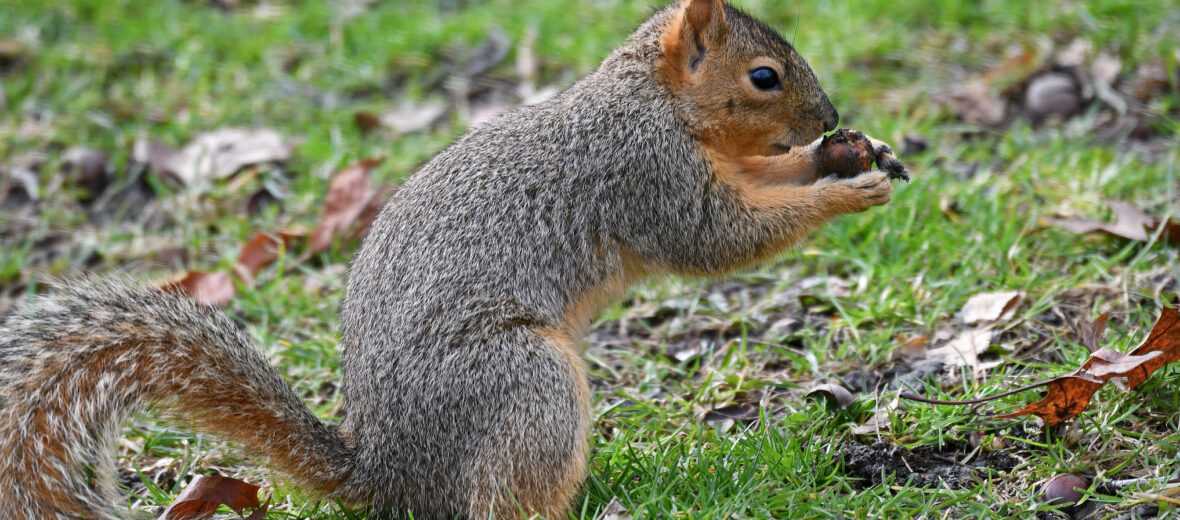
The eastern fox squirrel, aka Bryant’s fox squirrel, cat squirrel, Delmarva fox squirrel, fox squirrel, or stump-eared squirrel, is native to southern Canada, eastern United States, and northern Mexico. However, they have been introduced to British Columbia Canada, Ontario Canada, California, Washington and the western part of United States. They prefer open woodlands with open understories and a scattered covering of trees, like hickories, oaks, pines, and walnuts. They have also been observed in urban and suburban settings. Due to their wide spread populations and stable numbers, these squirrels are listed as Least Concern by the IUCN.
First the Stats…
Scientific name: Sciurus niger
Weight: Up to 1.8 lbs.
Length: Up to 17 inches, plus up to an 11 inch tail
Lifespan: Up to 18 years
Now on to the Facts!
1.) Although mainly terrestrial (spend their lives on the ground), these critters can also navigate trees too.
2.) Like other squirrels, they are solitary. They only come together to breed or when there is an abundance of food.
3.) The females and their young have been observed aggressively defending the central parts of their territory.
4.) Eastern fox squirrels are diurnal (active during the day).
5.) They nest nightly in tree-based nests, called dreys.
But wait, there’s more on the eastern fox squirrel!
6.) These critters will construct their nest from various leaves.
7.) Their coloration doesn’t change from winter to summer. However, they do gain fur tufts in their ears and pads of their hind and forelimbs during winter.
Did you know…?
Due to the accumulation of uroporphyrin, which builds up in their bones and teeth, this build up causes them to fluoresce a bright pink color when exposed to ultraviolet light. That’s right, glowing squirrels.
8.) Communication consists of body language, scenting, and a variety of barking sounds. They also make a chattering sound when alarmed.
9.) Fox squirrels chatter their teeth as a sign of aggression.
10.) A group of squirrels is called a colony, dray, or scurry.
But wait, there’s still more on the eastern fox squirrel!
11.) Being omnivores (eat plant and animal matter), these critters will eat acorns, hickory, walnuts, mulberries, Hawthornes, moths, beetles, birds, eggs, dead fish. They will also consume various plants, bark, and mosses.
12.) These squirrels are polygynandrous (promiscuous – males and females mate with several partners).
13.) Males often fight for breeding rights.
Did you know…?
Their ankles can rotate up to 180°, thus allowing them to scale down trees head first.
14.) Females breed up to 2 times a year.
15.) The female fox squirrel undergoes up to a 45 day gestation (pregnancy) that yields up to 3 young, called kittens.
But wait, there’s still a little more on the eastern fox squirrel!
16.) The kittens are born altricial (blind and helpless).
17.) Even though they have a stable population, generally speaking, they do suffer at the hands of habitat destruction and hunting, in certain locales.
18.) The squirrel is a Native American symbol of preparation, thriftiness, and trust.
19.) The name squirrel hails from the Greek word “Skiouros”, which translates to shallow tail. Even though most squirrels tend to have bushy tails.
20.) Being as they are rodents, their front teeth continuously grow and thus have to be worn down or they will become overgrown to the point that the squirrel can no longer eat.
But wait, there’s just a tad more on the eastern fox squirrel!
21.) As a testament to their intelligence, these and other squirrels will often pretend to bury food, in several locations, in order to throw off food thieves.
22.) When pursued, they will run in a zig zag pattern and to and fro, to confuse their attacker.
23.) They are preyed on by owls, hawks, foxes, coyotes, snakes, and humans.
24.) As mentioned, these squirrels will often pretend to hide food in order to confuse food thieves. However, they also tend to be forgetful and fail to remember where they actually did hide their food. This results in plant and tree growth, as the nuts they hide often germinate.
Now a Short Eastern Fox Squirrel Video!
Be sure to share & comment below! Also, check out the Critter Science YouTube channel. Videos added frequently!
Want to suggest a critter for me to write about? Let me know here.



